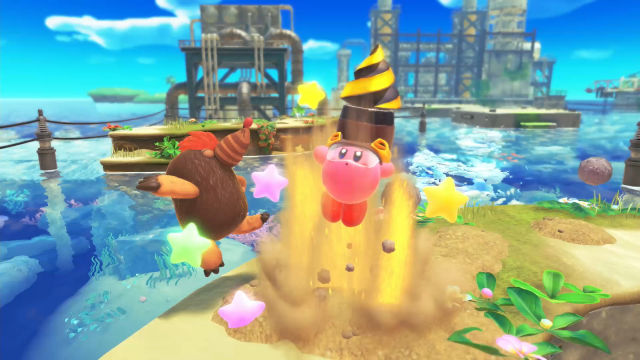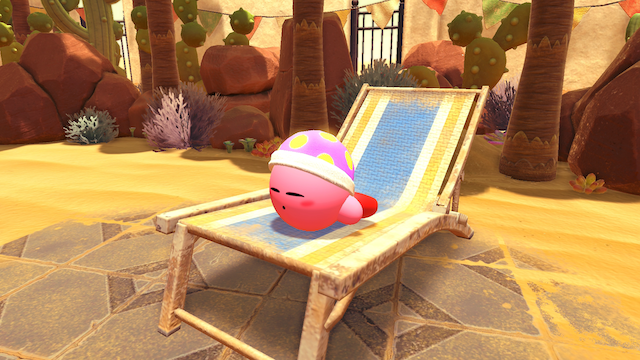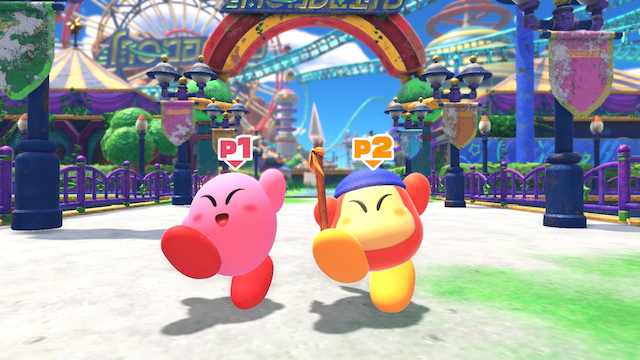Very fun combat; Mouthful Mode abilities are creative and well integrated into gameplay, don't feel like a shallow add on; wonderful soundtrack; gorgeous visuals; high replayability; plenty of post-game content
Lack of "restart stage" option while playing through a stage is a hassle given that stages are intended to be replayed and revisited
Welcome to another Backlog Review, where we take a look at an older game that fans might have sitting waiting to be played or are still considering giving a purchase. This time we’re looking at Kirby and the Forgotten Land.
From the time the first trailer for Kirby and the Forgotten Land was released, I was intrigued. The cute take on what appeared to be a post-apocalyptic, 3D world left me curious and desperate to learn more. What exactly had Kirby gotten himself into this time?
Luckily, we only had to wait six months between the game’s announcement and its release to find out. (With a little teaser demo in between to help tide us over until the full release.) In Kirby’s latest adventure, our hero goes from enjoying a ride around Planet Popstar on his Warp Star to being consumed by a portal to another world in the blink of an eye. He isn’t alone — the Waddle Dees (and a number of other familiar faces) get consumed along with him, and they all wind up in a strange new land, having to make sense of their surroundings.
Kirby wakes up face down on the shores of a beach, and after a small trek through the jungle (which makes for a streamlined and seamless tutorial), emerges on the outskirts of an abandoned city being retaken by nature. The game wastes no time in throwing you into the thick of combat, which I appreciate. Hand-holding isn’t my play style. Kirby has a total of 35 abilities in this game: 12 copy abilities, each of which can be upgraded twice (with the exception of Crash, which can only be upgraded once). I really appreciated the creativity that went into each ability’s design, and liked that the increase in power and damage output is noticeable from one ability upgrade to the next. The game encourages you to switch between abilities throughout a stage, especially to uncover secrets hidden away in the environment.
Mouthful Mode is really fun and Kirby’s new abilities get used in creative ways throughout the game: inhale a circular-shaped neon sign to blow giant gusts of air and take out enemies or steer a boat; inhale a vending machine to fire cans of soda and break down walls; inhale a lightbulb to navigate pitch-black rooms and power battery-powered moving platforms; and much, much more. The Mouthful abilities don’t feel like schticks, but like thoughtful methods of combat and puzzle solving that I looked forward to engaging with and discovering.
Replayability is high in Kirby and the Forgotten Land. Early in the game, Kirby gains a new companion, Elfilin, who tells him that the Waddle Dees built a town in this new land shortly after landing there. It was destroyed and they were captured by the Beast Pack, a group of hostile beasts who serve as the main antagonists of the game. Each level contains a certain number of captured Waddle Dees who are hidden throughout, and upon the completion of a level a checklist is displayed on-screen showing what actions the player needs to take to free all of them. Some actions are deliberately worded a bit vaguely to encourage exploration, and you’ll need to get a handle on all of Kirby’s various abilities to successfully free all of the Waddle Dees.
For veteran players of Kirby titles and 3D platformers, Kirby and the Forgotten Land isn’t a particularly hard game, even when playing on Wild Mode (the game’s higher difficulty level) versus Spring-Breeze Mode. But that doesn’t mean it isn’t challenging in other ways, nor does it mean that it’s a bore. Far from it. Waddle Dees aren’t just hiding in regular stages, but in boss stages, as well, and many of them require taking no damage from the boss to free, or beating the boss within a certain amount of time or with a particular copy ability. As the game progresses, enemies become trickier to read and dodge, making it much more difficult to free all of the Waddle Dees in the game.
However, given how the player is expected to replay stages to free the Waddle Dees and uncover all of the hidden secrets, it was really frustrating that HAL didn’t include a “restart” option in the pause menu. If you mess up and need to start over, you have to exit the level completely and then reselect it to jump back in.
HAL at least included a number of conveniences in other areas of the game, in particular in overworld navigation. The player guides Kirby and Elfilin on the Warp Star over the map, but holding down one of the shoulder buttons makes them fly much faster. You can also select which stage you want to play from a menu instead of flying over to the stage on the map. And because Waddle Dee Town is a hub you’ll return to often, you eventually unlock the ability to fast travel to it.
Speaking of Waddle Dee Town, I was surprised by how much there is to do there. Rescuing Waddle Dees frees them to return to town, where they’ll slowly rebuild and add different shops and buildings that Kirby can use to help him in his adventure or take some breaks in-between fighting. Kirby even gets his own little house to rest up in and decorate. From minigames to gacha machines to even a coliseum, Waddle Dee Town provides the player with a number of different novelties alongside resources to help him get through his journey.
While Waddle Dee Town is lighthearted and relaxing, I wasn’t expecting the dark turn that the story and overworld take towards the end of the game. The gradual shift from lush green cities and tropical shores to burning wastelands and experimental labs tells a cautionary tale of the dark side of progress. We get some horror-inspired scenes during the final battle that surprised me (in a good way), along with a final boss whose design felt like it took some inspiration from both the Final Fantasy and Pokémon franchises. For the sake of not spoiling anything I won’t get into plot details, but will only say that I didn’t go in expecting to enjoy the story as much as I did. After beating the game you’ll have plenty of post-game story and content to return to.
Saying that something has a lot of heart can often feel like a shallow compliment, but it’s definitely true of Kirby and the Forgotten Land. There’s a bit of a sense of sadness and loneliness in the abandoned environments, despite the amazing and upbeat soundtrack and Kirby’s ever-present positivity. But there’s also much joy conveyed whenever Kirby reunites with and frees Waddle Dees, along with a few particularly touching moments of friendship, loyalty, and sacrifice leading up to and during the final battle. It’s also clear that the developers at HAL really enjoyed inserting fun details and features into the world, like having both Kirby and his bombs float in water in inner tubes, or letting the player wave to Waddle Dees in Waddle Dee Town simply to get enthusiastic waves back.
So far, Kirby and the Forgotten Land is the best thing I’ve played this year and quite possibly might wind up being my game of the year. It’s a really fun, gorgeous, and creative game that was a delight to play, and I’d love to see HAL develop a sequel (or just another entry in the series) in the same style. Do yourself a favor and add this game to your Switch library.




 ShareThis
ShareThis








